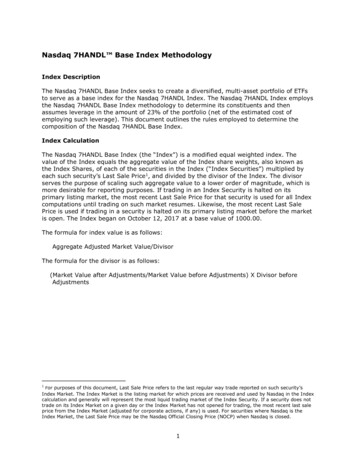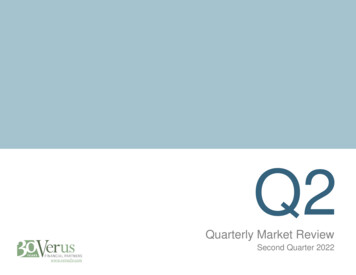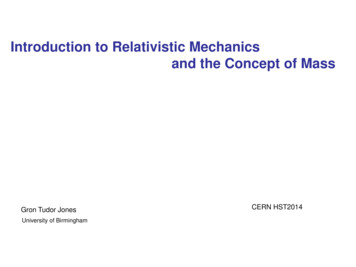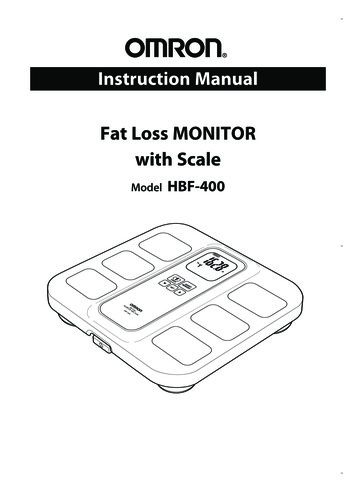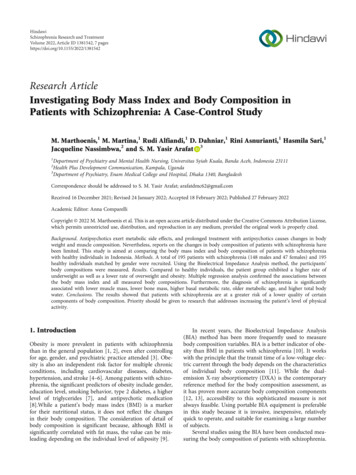
Transcription
HindawiSchizophrenia Research and TreatmentVolume 2022, Article ID 1381542, 7 pageshttps://doi.org/10.1155/2022/1381542Research ArticleInvestigating Body Mass Index and Body Composition inPatients with Schizophrenia: A Case-Control StudyM. Marthoenis,1 M. Martina,1 Rudi Alfiandi,1 D. Dahniar,1 Rini Asnurianti,1 Hasmila Sari,1Jacqueline Nassimbwa,2 and S. M. Yasir Arafat 31Department of Psychiatry and Mental Health Nursing, Universitas Syiah Kuala, Banda Aceh, Indonesia 23111Health Plus Development Communication, Kampala, Uganda3Department of Psychiatry, Enam Medical College and Hospital, Dhaka 1340, Bangladesh2Correspondence should be addressed to S. M. Yasir Arafat; arafatdmc62@gmail.comReceived 16 December 2021; Revised 24 January 2022; Accepted 18 February 2022; Published 27 February 2022Academic Editor: Anna ComparelliCopyright 2022 M. Marthoenis et al. This is an open access article distributed under the Creative Commons Attribution License,which permits unrestricted use, distribution, and reproduction in any medium, provided the original work is properly cited.Background. Antipsychotics exert metabolic side effects, and prolonged treatment with antipsychotics causes changes in bodyweight and muscle composition. Nevertheless, reports on the changes in body composition of patients with schizophrenia havebeen limited. This study is aimed at comparing the body mass index and body composition of patients with schizophreniawith healthy individuals in Indonesia. Methods. A total of 195 patients with schizophrenia (148 males and 47 females) and 195healthy individuals matched by gender were recruited. Using the Bioelectrical Impedance Analysis method, the participants’body compositions were measured. Results. Compared to healthy individuals, the patient group exhibited a higher rate ofunderweight as well as a lower rate of overweight and obesity. Multiple regression analysis confirmed the associations betweenthe body mass index and all measured body compositions. Furthermore, the diagnosis of schizophrenia is significantlyassociated with lower muscle mass, lower bone mass, higher basal metabolic rate, older metabolic age, and higher total bodywater. Conclusions. The results showed that patients with schizophrenia are at a greater risk of a lower quality of certaincomponents of body composition. Priority should be given to research that addresses increasing the patient’s level of physicalactivity.1. IntroductionObesity is more prevalent in patients with schizophreniathan in the general population [1, 2], even after controllingfor age, gender, and psychiatric practice attended [3]. Obesity is also an independent risk factor for multiple chronicconditions, including cardiovascular diseases, diabetes,hypertension, and stroke [4–6]. Among patients with schizophrenia, the significant predictors of obesity include gender,education level, smoking behavior, type 2 diabetes, a higherlevel of triglycerides [7], and antipsychotic medication[8].While a patient’s body mass index (BMI) is a markerfor their nutritional status, it does not reflect the changesin their body composition. The consideration of detail ofbody composition is significant because, although BMI issignificantly correlated with fat mass, the value can be misleading depending on the individual level of adiposity [9].In recent years, the Bioelectrical Impedance Analysis(BIA) method has been more frequently used to measurebody composition variables. BIA is a better indicator of obesity than BMI in patients with schizophrenia [10]. It workswith the principle that the transit time of a low-voltage electric current through the body depends on the characteristicsof individual body composition [11]. While the dualemission X-ray absorptiometry (DXA) is the contemporaryreference method for the body composition assessment, asit has proven more accurate body composition components[12, 13], accessibility to this sophisticated measure is notalways feasible. Using portable BIA equipment is preferablein this study because it is invasive, inexpensive, relativelyquick to operate, and suitable for examining a large numberof subjects.Several studies using the BIA have been conducted measuring the body composition of patients with schizophrenia.
2A hospital-based study found that male patients withschizophrenia under antipsychotic treatments have morebody fat, a higher percentage of fat, lower muscle mass,and lower body water compared to the healthy controls,while the female patients have a significantly lower percentage of body fat, higher muscle mass, and higher body watercompared to the health controls [9]. Furthermore, acommunity-based survey found that individuals withschizophrenia tend to have abdominal obesity, higher fatpercentage, and lower muscle mass [14]. Another studyfound that the body fat was associated with height, weight,BMI, and abdominal and waist circumference, while thebasal metabolic rate was associated with age, height, weight,abdominal, and waist circumference among patients withschizophrenia [15]. The inconsistency of factors associatedwith components of body composition between studiesdemands further investigations.While BMI studies have been conducted among patientswith mental health disorders in Indonesia [16–18], bodycomposition studies have not been conducted. The proximation of obesity or body fat among patients with schizophrenia in the country may therefore be erroneous with availabledata on BMI, and management protocols may not be wellinformed. The main objective of this study was to measureBMI and body composition (using BIA) among psychiatricinpatients with schizophrenia and compare them withhealthy controls. To the best of our knowledge, this is thefirst targeted study ever conducted in Indonesia. Based onthe findings of previous related studies and theories, wehypothesize that the patients with schizophrenia have higherBMI, total body water, and body fat but lower muscle mass,bone mass, physique rating, and basal metabolic rate compared to the healthy controls.2. Methods2.1. Study Subjects. The subjects were 195 inpatients (148males and 47 females) diagnosed with schizophrenia basedon DSM-IV diagnostic criteria at the Aceh Psychiatric Hospital in Indonesia. The subjects’ diagnoses were obtainedfrom their medical records. As a reference group, 195healthy volunteers were also included. The reference groupwas recruited from the general population using convenience sampling methods. Before inclusion into the study,the volunteers were screened with a semistructured interview to ensure the absence of both psychiatric disordersand the use of antipsychotics. The semistructured interviewconsists of questions whether they had ever been diagnosedwith any mental disorder or had the history of antipsychoticmedication use or think they had experienced any psychiatric symptoms. Only volunteers who confirm that they neverhad any of those problem were included in the study. Forboth the patients and volunteers, we also asked about theirage, marital status, education, and occupation. The financialstatus was examined by their occupation status, whetherthey had bank account and savings, either at the bank orelsewhere. Data collection was conducted between Juneand August 2020. The study was approved by an ethics committee at Universitas Syiah Kuala, and all participants pro-Schizophrenia Research and Treatmentvided informed consent before participating in the study.Permit for data collection among patients with schizophrenia was also obtained from the psychiatric hospitalmanagement.2.2. Procedure. The subjects’ demographic information andmedications were compiled from their medical records,and the patients’ antipsychotic medication was convertedto a chlorpromazine equivalent [19]. Body compositionwas measured with the Tanita RD-953 analyzer [20]. Thismeasurement procedure requires the subject to stand barefooted on the analyzer, while the height, date of birth, andlevel of activity were entered into the device. The device thencalculates their weight, BMI, body fat percentage, musclemass, muscle quality score, physique rating, bone mass, visceral fat, basal metabolic rate, metabolic age, and total bodywater. In addition, the blood pressure was measured usingelectronic blood pressure equipment while in a sittingposition.The body fat percentage was defined as the proportion offat to the total body weight. Muscle mass is the predictedweight of muscle in the body, which includes the skeletalmuscle, smooth muscles, and water contained in the muscles. Muscle quality score is calculated by the amount ofmuscle mass against the individual height. The larger score,the more muscle mass an individual has. Physique ratingmeasures the muscle and body fat level and is rated as oneof nine body types. Bone mass predicts the weight of boneminerals in the body. Visceral fat explains the amount offat in the abdominal area to protect the vital organs. Basalmetabolic rate is the daily minimum level of energy or calories that the body needs when at rest to function effectively.The metabolic age is the comparison of individual basal metabolic rate to the average basal metabolic rate of the chronological age group. Total body water is the amount of fluid inthe individual body [21]. Furthermore, BMI was categorizedas the following: underweight (BMI 18:5), normal(18:5 BMI 24:9), overweight (25 BMI 27), and obese(BMI 27).2.3. Statistical Analysis. Demographic and clinical characteristics were analyzed using descriptive statistics indicating thenumber and percentage, mean and standard deviation (SD),or median and interquartile range (IQR). The differences indemographic and clinical variables between the patientsand the control group were performed using the Chisquared test for categorical data and independent sample t-test analyses for continuous data. The independent samplet-test was also used to calculate the mean differences in bodycomposition between the groups. Furthermore, multiple linear regression analysis was performed to predict demographic and other variables that are independentlyassociated with each component of body composition. Theindependent variables associated with the components ofbody composition were included in the multiple linearregression analysis. Only variables with a significant p value( 0.05) were reported. Data analysis was carried out usingthe STATA 13 statistical software [22].
Schizophrenia Research and Treatment3. Results3.1. Demographics. The mean (SD) age of all participantswas 34 years (7.5), and the patients with schizophrenia wereolder, on average (36 years) (0.6), than the control group (32years) (0.6) (p 0:001). More than half (63.8%) of the control group was married, while only approximately onethird (36.2%) of the patients were married (p 0:001). Thevast majority of the patients only graduated from elementaryschool (98.3%), whereas the majority of the control grouphad a university education level (95.2%). Furthermore, thevast majority of the patient’s group were jobless or not working at the moment (80%), did not have bank account(97.4%), and did not have any savings, either at the bankor somewhere else (86%), indicating a low socioeconomicstatus of the patient group. No difference in systolic and diastolic blood pressures was observed. The median dosage ofmedication converted to a chlorpromazine equivalent was475 mg per day (IQR 400-700). Detailed sociodemographic and clinical characteristics of the study participants are presented in Table 1.3.2. Body Composition Measurements. Table 2 shows the differences in body composition between patients with schizophrenia and healthy controls. Overall, the patients withschizophrenia have a lower mean of body composition components compared to the healthy controls, except for metabolic age and total body water. The patients were shorterin height and lower in weight, BMI, muscle mass, bone mass,and basal metabolic rate (p 0:001) compared to the healthycontrols. In addition, their mean metabolic age was older(p 0:03), and their total body water was higher than thecontrol group (p 0:001). A mean difference of body fat,muscle quality score, physique rating, and visceral fatbetween the groups was not observed (p 0:05). The proportion of BMI categories between groups was also significantly different (p 0:001). The patients’ group has ahigher underweight proportion but less prevalence in theoverweight and obese groups. The details of the differencein BMI between patients and healthy controls are presentedin Table 3.3.3. Multiple Regression Analysis. Further statistical analysisconfirms that BMI was associated with all measured bodycomposition factors. BMI was associated with a higher bodyfat percentage, heavier muscle mass, better muscle quality,lower physique rating, higher bone mass, a larger amountof visceral fat, higher basal metabolic rate, older metabolicage, and lower total body water. Similar to BMI, genderwas also associated with all components of the body composition, except with muscle quality and physique rating. Furthermore, schizophrenia was independently and significantlyassociated with lighter muscle mass, lower bone mass, higherbasal metabolic rate, older metabolic age, and more totalbody water. Regular exercise was also significantly associatedwith a lower percentage of body fat, heavier muscle mass, better muscle quality, better physique rating, heavier bone mass,and lower visceral fat. Detailed regression analyses examining the association between the diagnosis of schizophrenia3under antipsychotic treatments and body composition arepresented in Table 4.4. DiscussionThis study examined the BMI and body composition ofpatients with schizophrenia compared with healthy controls.Patients undergoing antipsychotic treatment have a lowermean of muscle mass, bone mass, and basal metabolic ratewhile also exhibiting an older metabolic age and a higherpercentage of body water compared to healthy subjects.Some of the findings in this study are in line with the previous reports, whereas others contradict the literature.Previous studies have indicated that body fat mass andbody fat percentage were higher in patients with schizophrenia than healthy individuals [9, 23]. In contrast, this studysuggests that both groups have an average body fat of25 kg, and no statistical difference was found between thegroups. The lower muscle mass in the patients’ group foundin this study is in line with an earlier report [9], which statedthat these findings are associated with several factors, including age and low physical activity [24]. Therefore, our findings are relevant to the treatment condition of the studypopulation, as the vast majority of patients were locked innursing wards and barely had any physical activity.A relatively higher rate of underweight and a lower rateof overweight and obesity among the patient group compared to the normal controls were found in this study. Thefinding of 10.3% of patients with underweight has decreasedfrom the 17% underweight rate reported in a previous studyin the same setting [18], but it is still relatively higher thanthe rate of underweight in patients with schizophreniareported in a recent meta-analysis (6.2%) [25]. Nevertheless,the rate of overweight and obesity among the patients haschanged from 8% and 5% reported earlier [18] to 7.7% and18.5% found in this study, respectively. A lower rate of overweight and obese among inpatients with schizophreniamight be because of the majority of the patients come fromlow socioeconomic groups with financial difficulties. Inother words, the patients had been poor and could not affordadequate food before hospitalization. During hospital treatment, the patients only eat food provided by the hospitaland barely any snacks in between. Therefore, their bodyweight was most likely to be within normal weight. Also,the financial status of the patients, where the fast majoritydid not have any occupation, had no bank account, andhad no savings, confirms their low socioeconomic status.Furthermore, following our earlier study dissemination, thepsychiatric hospital management has made several changesconcerning the meal and nutritional management of thepatients. These changes include the employment of newnutritionists and the replacement of the food supplier, thusproviding better services. The improvement of the prehospital financial condition of the patients might also be responsible for the higher rate of obesity during hospitalization.The correlation between BMI and all body compositioncomponents measured is consistent with previous reports[9, 23, 26]. Despite BMI being a marker for nutritional statusin patients with schizophrenia, it may not reflect changes in
4Schizophrenia Research and TreatmentTable 1: Sociodemographic and clinical characteristics of participants (n 390).CharacteristicsTotalSchizophreniaControlx2 or tp valueAge (years old)34 7:536 0:632 0:64.80.001 360.001 232.60.001 199.20.001 343.50.001 267.70.001 Marital status (%)UnmarriedMarried177 (45.4)213 (54.6)118 (66.7)77 (36.2)59 (33.3)136 (63.8)EducationElementary (1-6 yrs)High school (7-12 yrs)University117 (30.0)126 (32.3)147 (37.7)115 (98.3)73 (57.9)7 (4.8)2 (1.7)53 (42.1)140 (95.2)OccupationJobless or not workingIrregular jobFormal job95 (24.4)161 (41.3)134 (34.4)76 (80)118 (73.3)1 (0.7)19 (20)43 (26.7)133 (99.3)Having bank accountYesNo197 (50.5)193 (49.5)7 (3.6)188 (97.4)190 (96.4)5 (2.6)Having savings (at the bank or elsewhere)YesNoSystolic blood pressure (mmHg)168 (43.1)222 (56.9)121 524 (2.4)191 (86)120 73164(97.6)31 (14)122 110.360.71Diastolic blood pressure (mmHg)84 1184 1384 90.450.65Table 2: The difference in body composition between the patients and healthy controls.SchizophreniaMean (SD)ControlMean (SD)t-testp valuecmkgkg/m2%kgPoint1-9 161 (8.2)60.6 (11.9)23.2 (4.9)25.1 (10.3)42.7 (6.7)64.8 (12.9)166 (6.2)68.8 (12.7)25.1 (4.2)25.5 (9.9)47.5 (9.1)65.6 10.543.6 (2.9)4.1 (1.6)1.50.11kg1-59 2.4 (0.3)2.7 (0.4)7.60.001Visceral fat rating7.6 (4)8.1 (4)1.20.2Basal metabolic rateMetabolic ageTotal body waterkcalYear%1285 (190)38 (11)50.5 (6.8)1461 (244)36 (9)47.7 (5.7)7.912.14.20.0010.030.001Body compositionHeightWeightBody mass indexBody fat percentageMuscle massMuscle quality scorePhysique ratingBone massRange score (unit)Table 3: The difference in body mass index between patients and healthy control group.Body mass indexUnderweightNormalOverweightObeseTotaln (%)Schizophrenian (%)29 (7.4)212 (54.4)63 (16.2)86 (22)20 (10.3)124 (63.5)15 (7.7)36 (18.5)Controln (%)9884850(4.6)(45.1)(24.6)(25.7)x2p value 0.00129.85
Schizophrenia Research and Treatment5Table 4: Multiple regression analysis for the detailed bodycomposition.VariableBody fatGenderRegular exerciseBMIMuscle massGenderRegular exerciseSchizophreniaBMIMuscle qualityAgeRegular exerciseBMIPhysique ratingRegular exerciseBMIBone massGenderRegular exerciseSchizophreniaBMIVisceral fatAgeGenderRegular exerciseWeightBMIBasal metabolic rateGenderSchizophreniaBMIMetabolic ageAgeGenderSchizophreniaBMITotal body waterGenderBMISchizophreniaβ-Coefficientp value-10.16-2.21.32 0.0010.018 0.00111.162.47-3.390.73 0.0010.004 0.001 0.001-0.185.430.290.0310.0030.0340.92-0.130.029 0.0010.490.10-0.20.04 0.0010.038 0.001 0.0010.112.73-0.710.070.52 0.001 0.0010.027 0.001 0.001250.97-26.1425.63 0.001 0.001 0.0010.68-6.011.831.05 0.001 0.0010.011 0.0014.29-0.691.47 0.001 0.0010.005other relevant interventions during hospitalization. As such,this study also highlights the importance of regular exercisefor improving the body composition of the study subjects.A significant decrease in bone mass among the patients’group was found. This is associated with female gender,irregular or no exercise, lower BMI, and the diagnosis ofschizophrenia. Low bone mineral density is common inpatients with schizophrenia [28, 29], and antipsychotic medication is one of the risk factors [29]. However, reports havealso indicated that long-term clozapine may protect bonedensity [30, 31]. Regular exercise also increases bone massin female adolescents [32]. Further studies might considerwhether providing more physical activity and other possibleinterventions could improve patients’ bone mineral density.This study has several limitations. First, it was conductedduring the COVID-19 outbreak. Due to the social distancingpolicy implemented by the local government, a limited number of patients and healthy controls were included in thestudy. Second, only hospitalized patients were included,leaving outpatients or those living in the community butusing antipsychotics unexamined. Third, several importantinformation such as the age of onset, duration of illness,symptom severity, functional level, and medication was notcollected from the patients. Last, the reference group wasonly matched with gender and not age. Future researchersmight consider collecting the abovementioned informationfrom the patients, matching for both age and gender, andincluding outpatients with schizophrenia or those living inthe community in their studies.5. ConclusionThis study highlighted several issues. First, cases of underweight still prevail in this population, despite the rate beinglower than previously reported. Second, the diagnosis ofschizophrenia is associated with poorer body compositioncompared to healthy subjects. Lastly, physical activity shouldbe proposed to patients as part of daily treatment duringhospitalization.Data AvailabilityThe data that support the findings of this study are availableon request from the corresponding author.DisclosureThe funding source has no implications for the conduct andthe result reported in this study.Conflicts of Interestbody composition. Positive correlations between BMI scoreand body fat percentage and visceral fat score confirm thatas the BMI increases, the other two variables also increase.The increased BMI in patients with schizophrenia is the consequence of antipsychotic medications, psychosocial andsocioeconomic risk factors, and an unhealthy lifestyle [27].Behavioral interventions that control the nutritional intakeand encourage regular exercise are proposed, along withThe authors declare no conflict of interest to disclose.Authors’ ContributionsMS, MA, HS, and JN wrote the protocol and monitored thedata collection. RD, RN, and DR conducted the data collection and data analysis. MS performed the data analysis andwrote the initial manuscript. YA contributed to the critical
6Schizophrenia Research and Treatmentreview of the manuscript. All authors have approved thefinal version of the article.AcknowledgmentsThe authors wish to thank the participants of this study. Thestudy was funded by the LPPM of Universitas Syiah Kuala.The work was supported by an award grant to Dr. Marthoenis, Ms. Martina, and Ms. Hasmila Sari by the Institute forResearch and Community Services (LPPM), UniversitasSyiah Kuala.[14][15][16]References[1] A. Annamalai, U. Kosir, and C. Tek, “Prevalence of obesity anddiabetes in patients with schizophrenia,” World Journal of Diabetes, vol. 8, no. 8, pp. 390–396, 2017.[2] F. B. Dickerson, C. H. Brown, J. A. Kreyenbuhl et al., “Obesityamong individuals with serious mental illness,” Acta Psychiatrica Scandinavica, vol. 113, no. 4, pp. 306–313, 2006.[3] I. M. Cameron, R. J. Hamilton, G. Fernie, and S. A. MacGillivray, “Obesity in individuals with schizophrenia: a case controlled study in Scotland,” BJPsych open, vol. 3, no. 5,pp. 254–256, 2017.[4] K. C. Sung, W. S. Jeong, S. H. Wild, and C. D. Byrne, “Combined influence of insulin resistance, overweight/obesity, andfatty liver as risk factors for type 2 diabetes,” Diabetes Care,vol. 35, no. 4, pp. 717–722, 2012.[5] V. Kotsis, K. Tsioufis, C. Antza et al., “Obesity and cardiovascular risk,” Journal of Hypertension, vol. 36, no. 7, pp. 1441–1455, 2018.[6] V. A. Chouinard, S. M. Pingali, G. Chouinard et al., “Factorsassociated with overweight and obesity in schizophrenia, schizoaffective and bipolar disorders,” Psychiatry research,vol. 237, pp. 304–310, 2016.[7] Q. Li, X. Du, Y. Zhang et al., “The prevalence, risk factors andclinical correlates of obesity in Chinese patients with schizophrenia,” Psychiatry Research, vol. 251, pp. 131–136, 2017.[8] V. Mazereel, J. Detraux, D. Vancampfort, R. van Winkel, andM. De Hert, “Impact of psychotropic medication effects onobesity and the metabolic syndrome in people with seriousmental illness,” Frontiers in Endocrinology, vol. 11, no. October, pp. 1–10, 2020.[9] N. Sugawara, N. Yasui-Furukori, S. Tsuchimine et al., “Bodycomposition in patients with schizophrenia: comparison withhealthy controls,” Annals of general psychiatry, vol. 11, no. 1,p. 11, 2012.[10] J. K. Sharpe, N. M. Byrne, T. J. Stedman, and A. P. Hills, “Bioelectric impedance is a better indicator of obesity in men withschizophrenia than body mass index,” Psychiatry Research,vol. 159, no. 1–2, pp. 121–126, 2008.[11] U. G. Kyle, I. Bosaeus, A. D. De Lorenzo et al., “Bioelectricalimpedance analysis–part I: review of principles and methods,”Clinical Nutrition, vol. 23, no. 5, pp. 1226–1243, 2004.[12] R. B. Mazess, H. S. Barden, J. P. Bisek, and J. Hanson, “Dualenergy X-ray absorptiometry for total-body and regionalbone-mineral and soft-tissue composition,” The AmericanJournal of Clinical Nutrition, vol. 51, no. 6, pp. 1106–1112,1990.[13] M. Marra, R. Sammarco, A. De Lorenzo et al., “Assessment ofbody composition in health and disease using 26][27][28][29][30]impedance analysis (BIA) and dual-energy X-ray absorptiometry (DXA): a critical overview,” Contrast Media & MolecularImaging, vol. 2019, article 3548284, pp. 1–9, 2019.S. E. Saarni, S. I. Saarni, M. Fogelholm et al., “Body composition in psychotic disorders: a general population survey,” Psychological medicine, vol. 39, no. 5, pp. 801–810, 2009.A. Wysokiński and I. Kłoszewska, “Assessment of body composition using bioelectrical impedance in patients with schizophrenia – preliminary report,” Archives of Psychiatry andPsychotherapy, vol. 16, no. 1, pp. 31–37, 2014.S. C. Park, A. Tripathi, A. Avasthi et al., “Relationship betweenbody mass index and extrapyramidal symptoms in Asianpatients with schizophrenia: the Research on Asian Psychotropic Prescription Patterns for Antipsychotics (REAP-AP),” Psychiatria Danubina, vol. 32, no. 2, pp. 176–186, 2020.N. Susilowati, D. Hanim, and Y. L. R. Dewi, “Body mass indexof schizophrenic patients with combined antipsychotic therapy,” International Journal of Nutrition Sciences, vol. 5, no. 1,pp. 7–12, 2020.M. Marthoenis, M. Aichberger, I. Puteh, and M. SchoulerOcak, “Low rate of obesity among psychiatric inpatients inIndonesia,” International Journal of Psychiatry in Medicine,vol. 48, no. 3, pp. 175–183, 2014.S. W. Woods, “Chlorpromazine equivalent doses for the neweratypical antipsychotics,” The Journal of Clinical Psychiatry,vol. 64, no. 6, pp. 663–667, 2003.Tanita Corp, Tanita RD 953 Intruction Manual, 2020.Tanita Corp, “Time to find out what you’re made of ! [Internet],” 2022, asurements/.StataCorp, Stata Statistical Software: Release 13, StataCorp LP,Collage Station, TX, 2013.B. Konarzewska, E. Stefańska, A. Wendołowicz et al., “Visceralobesity in normal-weight patients suffering from chronicschizophrenia,” BMC Psychiatry, vol. 14, no. 1, pp. 1–9, 2014.R. N. Baumgartner, D. L. Waters, D. Gallagher, J. E. Morley,and P. J. Garry, “Predictors of skeletal muscle mass in elderlymen and women,” Mechanisms of Ageing and Development,vol. 107, no. 2, pp. 123–136, 1999.N. Sugawara, K. Maruo, T. Sugai et al., “Prevalence of underweight in patients with schizophrenia: a meta-analysis,”Schizophrenia Research, vol. 195, pp. 67–73, 2018.S. Yim Loh, A. Yusof, and A. Kadir Abu Bakar, “Visceral obesity in the normal-weight people-comparing chronic schizophrenia and healthy control subjects,” Brain and Nerves,vol. 1, no. 2, pp. 1–6, 2017.P. Manu, L. Dima, M. Shulman, D. Vancampfort, M. De Hert,and C. U. Correll, “Weight gain and obesity in schizophrenia:epidemiology, pathobiology, and management,” Acta Psychiatrica Scandinavica, vol. 132, no. 2, pp. 97–108, 2015.P. T. Tseng, Y. W. Chen, P. Y. Yeh, K. Y. Tu, Y. S. Cheng, andC. K. Wu, “Bone mineral density in schizophrenia an update ofcurrent meta-analysis and literature review under guideline ofPRISMA,” Medicine, vol. 94, no. 47, article e1967, 2015.C. Y. Chen, H. Y. Lane, and C. H. Lin, “Effects of antipsychotics on bone mineral density in patients with schizophrenia: gender differences,” Clinical Psychopharmacology andNeuroscience, vol. 14, no. 3, pp. 238–249, 2016.C. H. Lin, C. Y. Lin, H. S. Wang, and H. Y. Lane, “Long-termuse of clozapine is protective for bone density in patients withschizophrenia,” Scientific Reports, vol. 9, no. 1, pp. 1–7, 2019.
Schizophrenia Research and Treatment[31] C. H. Lin, K. H. Huang, Y. C. Chang et al., “Clozapine protectsbone mineral density in female patients with schizophrenia,”The International Journal of Neuropsychopharmacology,vol. 15, no. 7, pp. 897–906, 2012.[32] T. Okayama, K. Kinouchi, and H. Watanabe, “Lifestyle andenvironmental factors affecting bone mass in Japanese femaleadolescents,” Journal of Pediatric Nursing, vol. 56, pp. e55–e61, 2021.7
Research Article Investigating Body Mass Index and Body Composition in Patients with Schizophrenia: A Case-Control Study M. Marthoenis,1 M. Martina,1 Rudi Alfiandi,1 D. Dahniar,1 Rini Asnurianti,1 Hasmila Sari,1 Jacqueline Nassimbwa,2 and S. M. Yasir Arafat 3 1Department of Psychiatry and Mental Health Nursing, Universitas Syiah Kuala, Banda Aceh, Indonesia 23111
